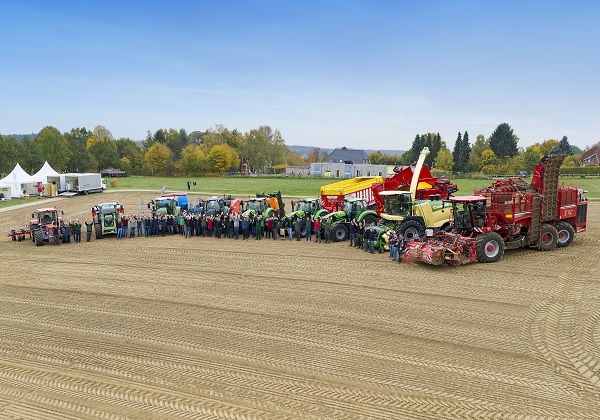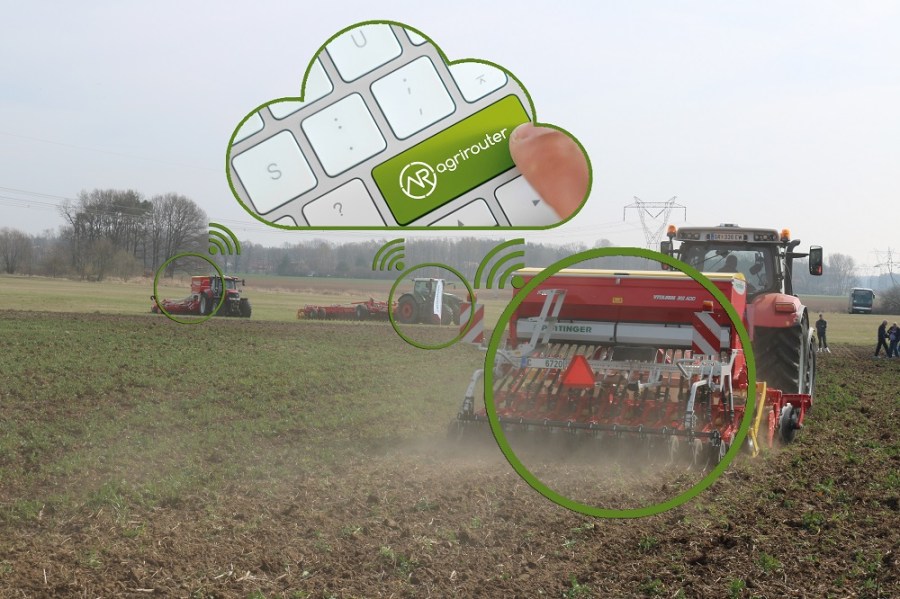Low-cost seamless data transfer is now available between machinery brands through Agrirouter. CPM gathers some digital developments.
Agrirouter not only reduces interface problems, it also improves and simplifies many steps in the agricultural production process.
By Tom Allen-Stevens
The web-based data exchange platform Agrirouter has now gone live, allowing farmers and contractors to create a free account and to start transferring information between machines of different brands and agricultural software.
Unveiled at Agritechnica in 2017, the development of the platform has been managed by German software company DKE-Data on behalf of a consortium of machinery manufacturers. Since then, it’s completed extensive tests and went online in time for the Paris SIMA show in Feb.

Currently, 11 large agricultural machinery manufacturers with many well-known brands are shareholders in the Agrirouter consortium.
“The Agrirouter is an important component of modern agriculture,” claims managing director of DKE-Data Dr Jens Möller. “It not only reduces interface problems, it also improves and simplifies many steps in the agricultural production process. The Agrirouter offers many advantages for farmers and contractors, including the fact that machine data can be used across manufacturers.”
This has been a fundamental problem that’s held back the adoption of precision farming technology. Individual components of a digitally enabled farm may work, but as soon as you get them to talk to each other, many precision farming users have found they’re speaking in different languages. While ISOBUS may have overcome many of the problems, transferring data remains a time-consuming and sometimes costly affair, especially between kit from different brands.
So what is Agrirouter? In essence, it’s a cloud-based data exchange platform working like a postal service, explains Jens. “Any data generated by a machine can be routed to connected agricultural software solutions. It’s also possible to route data from machine to machine and from one agricultural software solution to another.”
The routing must be set-up by the end user, whether that’s the farmer, contractor, adviser, or other party. “The envelopes with the data will never be opened by the Agrirouter, which will store the data messages for up to four weeks.”
The benefit is a simplified system for documentation of completed work, continues Jens. “Planned orders can be sent to the machine by telemetry and back to the user’s connected agricultural software after completion. The order-related co-operation between farmer and contractor will also become easier and more efficient for both sides as two Agrirouter accounts can be connected.”
The beauty of the system is that every connected endpoint talks the same language – every manufacturer and software provider that wishes to allow its customers to use the platform to exchange data integrates an application program interface (API) – the documentation to allow them to do so is provided free, with a one-off certification fee. That means anything a user transfers over the platform to an endpoint will be in a message format that machine or software will understand.
“Currently, 11 large agricultural machinery manufacturers with many well-known brands are shareholders in the Agrirouter consortium and the number of app and hardware providers (partners) is growing continuously. In a few years’ time, data exchange, which is controlled and supervised by farmers and contractors, will be part of everyday agricultural life,” says Jens.
And there are some big names involved: AGCO, Amazone, Grimme, Horsch, Krone, Kuhn, Lemken, Pöttinger, Rauch and SDF are in the consortium, with Exel Industries joining last year and bringing on board brands such as Holmer, Hardi, Berthoud and Agrifac. While many European agricultural software providers are now partners, in the UK, so far just Muddy Boots has indicated it’s developing an API for its Greenlight Grower Management software, although DKE-Data is in contact with further potential UK partners.
While the cost of registering for Agrirouter is free, there may be a charge to transfer your data. This will depend on how much data you exchange and how much of the cost the software provider wishes to pass on. Typically, a tractor exchanging basic data with two or three machines may cost in the region of €30-40/year (£25-34), indicates Jens. Your mobile phone provider may also charge for data transfer, depending on your contract.
The initiative started back in August 2014, recalls Jens. “Six companies from the current consortium started the initiative. They recognised that it doesn’t make sense to have different hard and software on farms that can’t communicate. So DKE-Data was founded to develop the solution and bring as many partners as possible on board.”
It took two years to develop the legal backbone and a clear product strategy for the not-for-profit platform – as almost all companies are competitors it was subject to antitrust evaluation. “Each shareholder that comes on board has just one vote, regardless of the size of the company, which ensures there’s no bias with the platform,” notes Jens.
The architecture uses industry-standard software used routinely by app developers. “It takes about a week or two for a new partner to integrate the interface and ensure it functions correctly,” he adds.
Pöttinger was one of the original consortium members and is among several companies developing retrofit solutions, allowing older machines to be connected, as well as integrating connectivity into current technology.
“Almost every tractor now has GPS and can be connected to another tractor and to implements – they’re not so much individual machines but part of a system,” says product specialist for mechatronics and hay tools Markus Reininger.
For newer machines that are telematics-ready, Agrirouter allows you to download a prescription map to the company’s Aerosem seed drill for example, via the CCI control terminal. For larger farms and contractors with a fleet of machines to look after, the aim is for real-time data transfer to help co-ordinate operations.
This is due to get even slicker in around July this year with the launch of Next Machine Management. This will provide a fleet-management solution suitable for all ISOBUS machines, developed by six partner companies – AGCO, Krone, Kuhn, Lemken, Pöttinger and Rauch, along with agricultural software company FarmFacts. It’ll allow task-based auto-documents to pass between machines seamlessly, with a further step also bringing in task-less communication, says Markus.
“But it’s not just for the larger operator. There will be a low-cost retro-fit solution and we envisage farms of all size making use of it – it’ll handle jobs as simple as counting bales.”
Jens believes such systems will become essential as the amount of data routinely transferred around a farm and between connected operators increases. “It’s like Autosteer – it took a few years for the technology to develop and then farmers realised how useful it is, so now it’s ubiquitous.
“Digitalisation on farm will continue, and the internet of things will bring farmers data from more and more sensors and software-based products. They present a lot of possibilities to radically transform on-farm operations. The challenge is to convince farmers to step into the cloud and explore.”
Soil sense informs the seeding operation
Pöttinger has developed a smart sensor that can adapt the output of a power harrow to soil conditions in real time.
The smart seeding unit uses a camera mounted between the power harrow and seeder unit on one of its combinations to gauge the roughness of the soil surface. This then automatically controls the tractor’s forward speed and PTO revolutions to bring about the optimum seedbed.
“This ensures a consistency of tilth and that the seed is planted at a consistent depth,” notes Pöttinger’s Markus Reininger. “It also optimises time, power, fuel and labour for what can be a costly field operation.”
The system is designed to work with the company’s combinations, such as the Aerosem twinned with its Lion power harrow. “The biggest difference is provided by the PTO speed of the power harrow – this can be varied by as much as 50% to create the optimum seedbed, provided you have the right ISOBUS standard fitted.”
Having developed a proof of concept, the prototype system is being refined, with a commercial launch expected in autumn 2020. It’s expected to work alongside Pöttinger’s Seed Complete system that allows variable rate seeding according to soil type.
“Like it or not, the power harrow is one of the most versatile machine for creating a seedbed. The more the process of seedbed preparation can be tailored to the soil condition, and the more this can be automated, the better,” says Markus.




